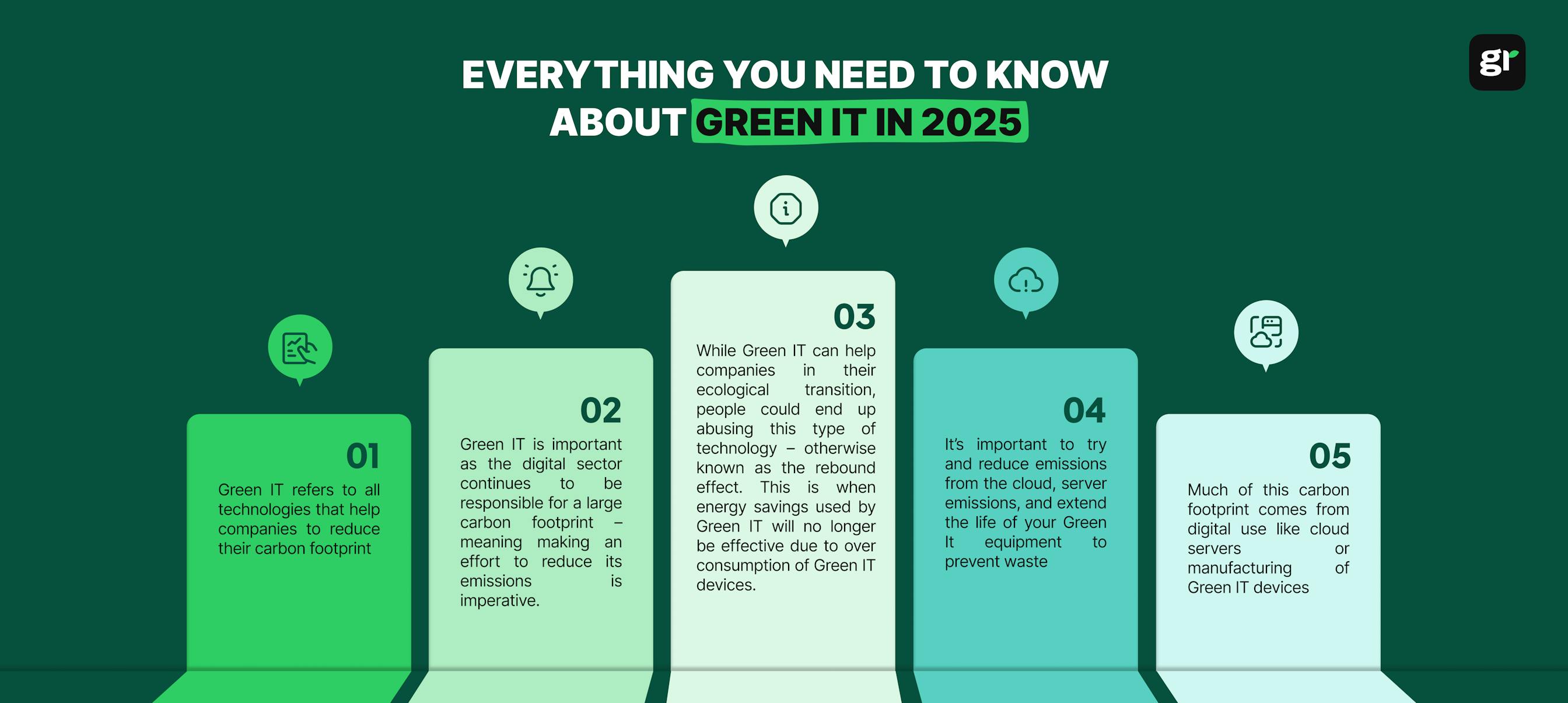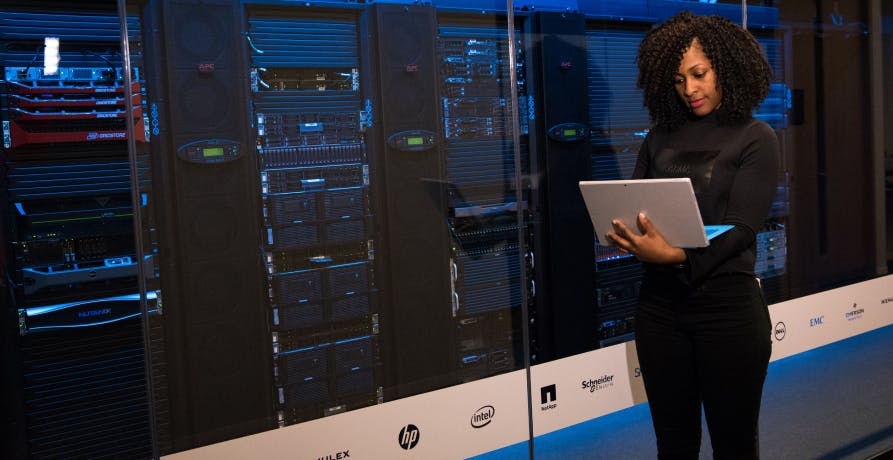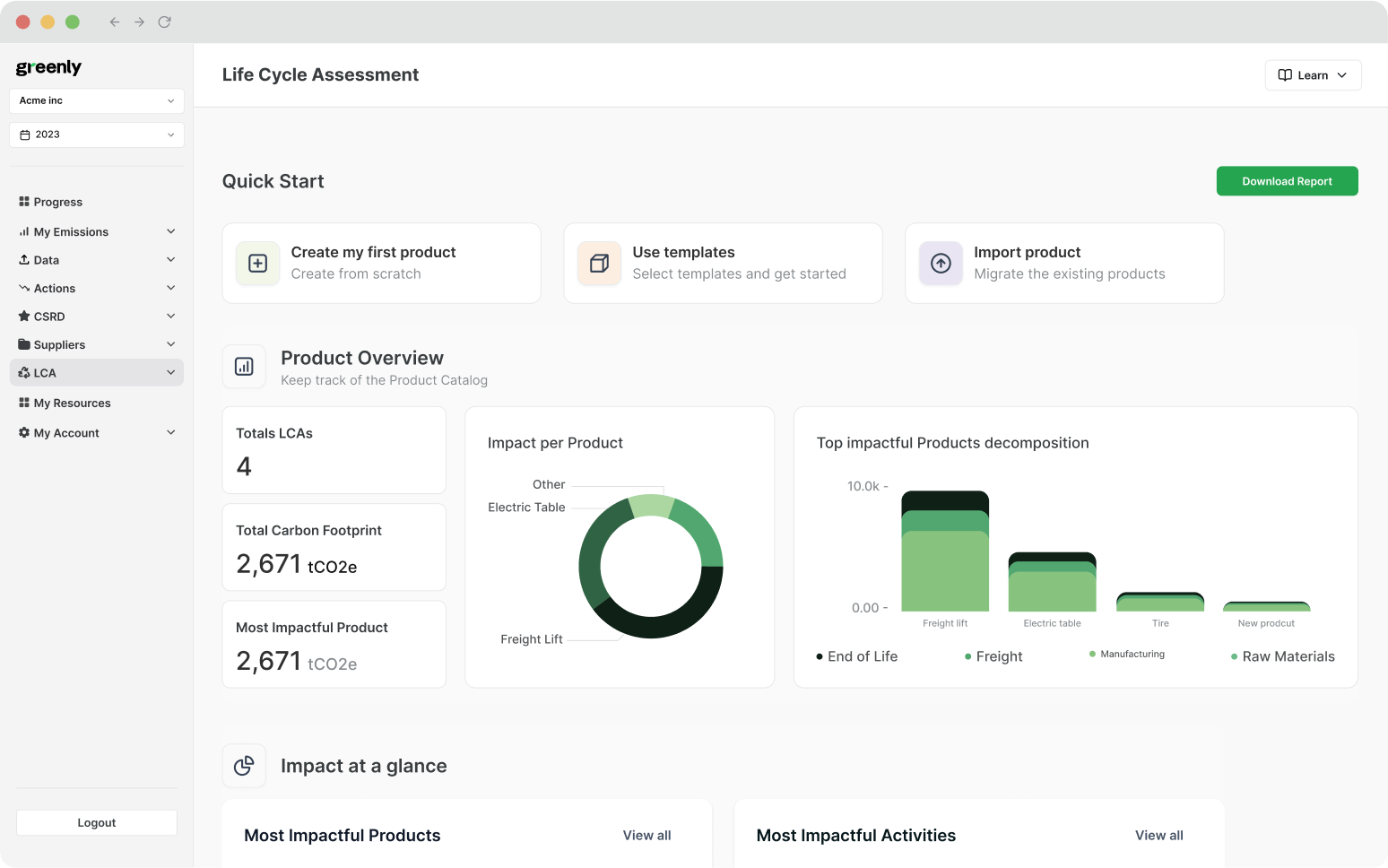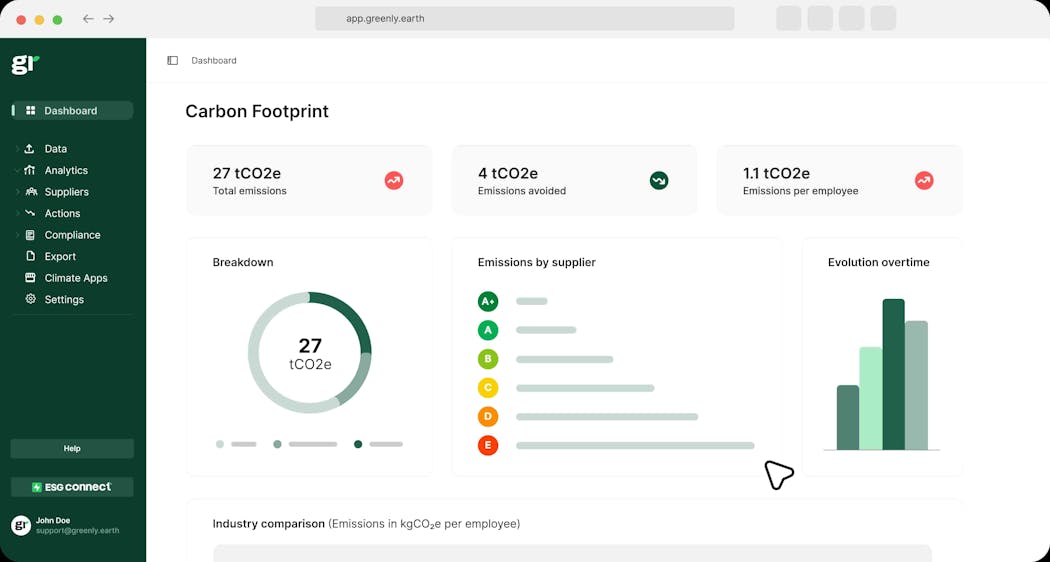ESG / CSR
Industries
Everything You Need to Know About Green IT in 2025



- The environmental impact of Green IT
- How to calculate the ecological impact of IT services
- How organizations can successfully address the negative effects of cloud-based services and intensive energy equipment
The intangible nature of the digital world means we tend to forget the significant environmental impact Green IT has on the environment, which according to the International Energy Agency (IEA), has been growing at an annual rate of 12% each year.
Today, things are changing: awareness of the material aspect of digital technology is increasing, such as with the catastrophic fire at OHV's data center in Strasbourg which destroyed 30,000 servers. This was followed by the March 2023 fire at Maxnod's data center in Saint-Trivier-sur-Moignans in France, which occurred in March 2023, which further highlighted the environmental vulnerabilities of digital infrastructure..
The issue is now at the forefront of the political agenda, and for good reason – since the consumption of digital technology accounts for up to 4% of global emissions. As the sector's emissions continue to rise exponentially, this makes Green IT one of the most pivotal new areas to keep an eye on as the world begins to become more cognizant regarding climate change and how technology could either be our greatest enemy or asset in the fight to mitigate further global warming.
In this article, Greenly will explain the fundamental issues to help you understand the challenges of Sustainable Information Technology (Sustainable IT) or Green IT, which provide a framework for addressing the environmental and social issues of the sector.
Definition of Green IT: Evidence-Based Approach to Sustainable Cloud Computing
Green IT (Green Information Technology) or Eco ICT (Information and Communication Technologies) has been developed to provide solutions to the ecological and social footprint of digital technology.
With the arrival of energy-intensive technologies including artificial intelligence data centers and high-resolution streaming services utilizing 5G data use and 8K displays, it’s time to take a closer look at what the concept of Green IT is seeks to achieve.
Green IT refers specifically to environmentally sustainable computing practices that encompass the design, production, use, and disposal of computing devices in order to reduce environmental impact across their complete lifecycle, as defined by the International Organization for Standardization (ISO) in standard ISO/IEC 30134.
However, this definition is incomplete. There are two complementary ways of defining the concept of Green IT, also known as “green computing”:
- Green IT refers to all comprehensive strategies and technologies that enable companies to improve their energy efficiency, reduce energy consumption, mitigate GHG emissions, and ultimately reduce their carbon footprint. Therefore, all the technologies that help to reduce the environmental impact of IT can be considered as a form of Green for IT.
- In addition, IT for Green covers the deployment of digital solutions set out to ensure that socio-economic principles are adopted, both at the company and societal level, in order to initiate the ecological transition.
What is the Scope of Green IT?
According to research from the University of Pittsburgh, it is crucial to employ the use of green computing practices, such as by utilizing power management, virtualization, and efficient cooling, to minimize the ecological impact of IT services
However, these numerous methods of implementing Green IT measures have resulted in several different terms and definitions that fall under the umbrella of Green IT. This can make it confusing to fully understand as new acronyms continue to emerge, but don't worry – Greenly will clearly explain each term in depth.
- Green IT 1.0 covers all information technology infrastructure optimization (methods, processes, software, hardware, etc.) that protects the environment through eco-design (Responsible Digital Design, or RDD), energy efficiency implementations certified through programs like ENERGY STAR, energy savings, waste management protocols compliant with WEEE (Waste Electrical and Electronic Equipment) regulations, and strategic procurement policies can lead to a reduction in energy usage and improve data center energy efficiency.
- Green IT 1.5 refers to all the telecommunications and network services required to design a Sustainable Development Information System (SDIS). This method meets a two-fold objective by reducing the footprint of communication infrastructure (networks, telephony, etc.) and simultaneously supporting the development of internal environmental policy (creating digital tools, minimizing travel through remote working, monitoring, reporting, evaluating employees’ environmental performance, etc.). This could include ISO 14001-compliant monitoring systems, standardized reporting frameworks, and evidence-based environmental performance evaluation methodologies.
- Green IT 2.0 involves strategically deploying information and communication technologies (ICTs) beyond internal optimization to encourage a broader environmental impact. This can include utilizing advanced computing solutions for comprehensive "external" environmental transformation across supply chains and customer ecosystems. The scope of 2.0 means thinking beyond simple optimization via the IT sector: creating disruptive eco-innovations i.e. changes in economic and behavioral models using ICT. Ultimately, the use of ICTs is intended to propel the push towards “external” environmental policy, to be applied outside of the company – seeking to benefits those outside of the organization and incite change.
The three way battle cards below will compare and contrast the different types of Green IT:
🌱 Green IT 1.0
- Focus on internal IT efficiency
- Reduces energy consumption of IT infrastructure
- Applies eco-design to hardware
- Encourages virtualization and dematerialization
- Measured primarily via carbon footprint
🔄 Green IT 1.5
- Extends sustainable practices to broader business operations
- Considers IT's role in supporting company-wide sustainability
- Introduces lifecycle thinking to IT projects
- Collaborates with CSR & operations teams
- Supports both digital and environmental performance
🌍 Green IT 2.0
- Uses digital tools to accelerate ecological transition
- Prioritizes sustainability in IT innovation strategy
- Drives change across entire value chain
- Empowers business models aligned with climate goals
- IT as a force for impact beyond internal operations
The Social and Societal Dimensions of Green IT
Remember, the original scope of Green IT 1.0 and 1.5 should be assessed with a clear and objective perspective.
This is because Green IT 1.0 and 1.5 aim to optimize the environmental footprint of digital technology itself. As the IEA has shared in reports how the development of a multi-various green equipment and software could lead to excess consumption, and could ultimately lead to even more harmful effects on the environment.
The "Rebound Effect" in Energy Efficiency
This concept is most often referred to as the famous rebound effect. The rebound effect refers to the phenomenon where the energy savings initially expected from a new technology are reduced, or even negated, due to increased usage or changes in behavior such as through the use of Green IT. The emergence of new behaviors and consumption patterns could have a profound impact on a society-wide scale.
When it comes to Green IT, there is a risk that people will end up abusing the use of certain types of technology – and ultimately not contribute to energy efficient targets or goals to reduce electronic waste or global electricity usage.
Examples of Excess Energy Consumption
An example of this phenomenon would be with someone who purchases a new, high definition energy efficient television – but starts to watch T.V. more than usual since they are enjoying the new, crisper image.
Nonetheless, this initial scope is a solid start to changing our thinking in this field. Comprehensive green software development frameworks like those established by the Green Software Foundation indicate that effective implementation can significantly reduce application carbon footprints techniques and improve the deployment of renewable energy sources.
The flip cards will provide additional examples of energy efficient technology potentially backfiring and resulting in excess energy consumption:
The Push to Reduce Carbon Emissions Worldwide
This approach should be taken further with Green IT 2.0, with the goal being to transform the way society operates in order to achieve science-based targets aligned with the IPCC's recommendation to reduce global GHG emissions by 45% by 2030 and reach net zero by 2050, and not only those caused by digital technology.
A final concept worth highlighting is Fair IT. Unlike the previous approaches, Fair IT primarily focuses on the working conditions of employees in the digital sector, rounding out the broader conversation around sustainable technology.
Although the main concern with Fair IT is hardware and software suppliers, users are also major stakeholders in the process because they can influence these suppliers by requiring them to make ethical commitments.
For example, with FairComputer’s “High-Tech No Rights” campaign, during which the association, after undertaking significant work on sourcing, asked the five largest suppliers to adopt a policy of social responsibility across their entire production chain.

What is the Digital Carbon Footprint Worldwide?
It is estimated that the carbon footprint linked to digital activities accounts for around 3 to 4% of the world’s total emissions – which represents about 2 gigatonnes of CO₂.
It can be challenging to grasp how our daily, digital activities could amount to such a whopping amount of greenhouse gas emissions. According to a study by the Think Tank Green IT, digital emissions come from the extraction and processing of raw materials, the assembly of components, as well as transportation. This usage also covers electricity consumption.
Sources of Emissions Impacting Climate Change
Digital technology emits a mass of carbon into the atmosphere equivalent to the weight of 200,000 Eiffel Towers. Sequestering that amount of carbon would, in theory, require covering one-third of the Earth’s land surface with mature forests.
The drop down section below will explain common culprits behind our increase in emissions in 2025:
The other sources (end-of-life, sales service, etc.) are considered insignificant in terms of CO2. However, end of life is responsible for considerable pollution and has an impact on biodiversity which must be taken into account on another level.
Furthermore, the manufacture of digital devices has additional effects other than emitting CO2. In particular, the extraction of rare-earth elements for electronic components raises many concerns.
To better understand how much is emitted by digital technology, let’s look at the calculations in more detail.
There are two types of digital use:
- On-site, such as via the local use of your computers and servers.
- The use of web services and “the Cloud”, which are operated through remote servers. We neglect this type of digital use, as the consumption isn't physically or visibly tangible to us, but the impact of this type of equipment is substantial. Remember, the Cloud does not have the same effect on the environment as a cloud floating across the sky.
The table below will further explain how the cloud can have an impact on energy efficiency and the IT industry:
| Cloud Factor | Impact on Energy Efficiency | Impact on the IT Industry |
|---|---|---|
| Data Center Demand | Increased demand for cloud services requires massive, energy-hungry data centers operating 24/7. | Leads to growth in infrastructure spending and pressure to innovate energy-efficient server technologies. |
| Global Accessibility | Cloud allows users to access data from anywhere, but this increases network traffic and transmission energy use. | IT must invest in global networks, edge computing, and better load balancing strategies. |
| Scalability | On-demand scalability can improve efficiency when resources are optimized, but poor management can lead to overuse. | Encourages development of better monitoring and orchestration tools to prevent waste. |
| Redundancy & Backups | Cloud systems often duplicate data across multiple servers for security, consuming more energy. | Raises operational costs and motivates more sustainable data replication practices. |
| AI & Big Data Workloads | Training AI models and processing large datasets require high-performance computing and extensive energy input. | Pushes IT to prioritize energy-efficient hardware and specialized chips (e.g., TPUs, GPUs). |

How the Environmental Impact of Mobile Devices and On-Site Data Centers is Calculated
The environmental impact of mobile devices and data centers is mainly caused by manufacturing and general usage of this equipment. The sole advantage is that the data relevant to the use of this equipment is easy to obtain: such as the time of usage, the terminal's electricity consumption, amount of computing equipment, and more.
Calculating the Impact of Manufacturing
First of all, in terms of manufacturing, it's easy to precisely measure your impact by taking into account each physical object, then breaking it down into sub-objects, and so on. This is the main purpose of the LCA methodology (“Life Cycle Analysis”). To estimate the ecological impact of a device, it is necessary to list the different emission sources for each component, by breaking them down into the fundamental building blocks: transportation, extraction of different raw materials, assembly, etc.
Therefore, it's important to remember that not all pieces of technology that qualify as Green IT will have the same environmental impact – as each component makes use of different natural resources, power management tools, efficient resource allocation, and energy efficient hardware.
Remember, there's no need to panic – as you don't need to know exactly which materials are used to make the SP-453 chip in your computer's hard drive. For example, the ecological impact of the sub-steps which you obtain a computer, server or screen have been accurately calculated in numerous studies.
Furthermore, many free publications are released each year detailing the LCAs of finished products. Calculators, such as the one we provide at Greenly, also use LCAs to measure the impact of manufacturing the equipment you use.
Calculating the Impact of Electricity Consumption & Equipment Usage
Secondly, there is the use of equipment and the electricity consumed. The consumption of your equipment can be calculated using its average electrical power supply and the time you spend using it.
You can skip this step if you are conducting an overall carbon assessment of your activities, because the use of your devices is included in the electricity you pay for. If this is the route your company has chosen to take to manage and measure energy efficiency, all you need to do is multiply the consumption by the carbon intensity of the electricity in the country where your business is located.
The carbon intensity of electricity is the number of kg of CO₂ emitted for each kWh of energy generated. Remember, this will vary from country to country, depending on the share of renewable and nuclear power in the energy mix.
However, this measurement becomes more complicated if you are using other people's electricity instead of your own. This is especially true for companies operating websites or providing web services.
This is because a visit to your website will consume electricity in two ways:
- At the visitor’s end to display the page on their device
- Via the network which will need energy to transport the data from the page to the user
The Ecological Impact of Cloud Services: Cloud Computing Sustainability
Cloud services, unlike physical servers, are virtual – and consumption is shared.
Therefore, a share of the emissions from the construction of equipment and manufacturing and deployment of hardware infrastructure must be allocated according to each customer's usage patterns.
In fact, a study from the Lawrence Berkeley National Laboratory revealed that properly implementing these methodologies could help to reduce emissions by a whopping 87%, or 23 billion kilowatt-hours. This reveals how taking these discrepancies into detailed account could contribute to significant change such as by allowing for utility cost savings and measurable environmental benefits.
In addition, the electricity consumption of Cloud services is broken down into two parts:
- The electricity consumption of the equipment and IT infrastructure components: including enterprise-grade network switches, virtualization servers, load balancers, storage arrays, and various routers
- The ancillary power consumption and essential supporting systems related to server cooling, lighting the building, and maintenance operations
The consumption of computational resources and equipment is estimated using the information provided by each supplier, such as the equipment used and pricing methods, in order to give an accurate overall picture of the consumption of each service.


Case Study: Google Cloud’s Decarbonization Initiatives
Google Cloud has been a leader for sustainability in the tech industry, as the company has implemented numerous initiatives to reduce their carbon footprint and promote environmental responsibility.
Key Initiatives
- Carbon-Neutral Operations: Google Cloud has contributed to carbon neutrality since 2007 by offsetting its carbon emissions through the purchase of renewable energy and carbon credits.
- 100% Renewable Energy Matching: In 2017, and again in 2020, Google matched 100% of its global electricity consumption with purchases of renewable energy, making it the largest corporate to achieve this challenging objective.
- 24/7 Carbon-Free Energy Goal: Google aims to have all of their data centers and campuses operate on 24/7 carbon-free energy by 2030. This pioneering goal involves sourcing carbon-free energy for every hour of every day, which exceeds their initial goal of annual matching.
- Energy-Efficient Data Centers: Google Cloud has invested in machine learning and artificial intelligence to optimize the energy efficiency in their data centers, ultimately working to reduce energy consumption for cooling and other operations.
- Carbon-Aware Computing: According to Cornell University, Google has developed systems that schedule workloads according to the amount of available of renewable energy, therefore mitigating the carbon intensity of its computing operations.
Overall, these initiatives have helped Google Cloud to reduce their carbon emissions and set a primary example for sustainability in cloud computing. The company's commitment to renewable energy and innovative technologies demonstrates how other companies could follow suit in leading the way towards greater environmental responsibility.
Additional Impacts of Cloud Services & Communication Technology
Operators make every effort to reduce the structure's consumption by using economies of scale and state-of-the-art equipment (as a customer, always beware of greenwashing which has emerged so quickly).
Understanding PUE
PUE, which stands for “Power Usage Effectiveness”, is the ratio between the total consumption of the data center and the electricity consumption of the IT equipment. This ratio is used to calculate the additional electricity consumption, such as for cooling, lighting, and more.
Most of the leading providers on the market directly publish their PUE, which averages around 1.5 PUE. Therefore, selecting a data center with low PUE constitutes an important method of decarbonization for companies.
Large Distances Between Servers
Moreover, the servers hosting Cloud services are often located far from the initial point of call. For example, Amazon Web Services, the Cloud service arm of Amazon, has the majority of its European servers based in Ireland.
In addition to the carbon intensity of electricity, which can vary by a factor of 10 between two European Union countries, the transportion of data must also be taken into account, which can amount to significant volumes, thus representing a non-negligible share of network consumption.

Green IT: How to Implement Digital Sobriety in Your Company
If your company has successfully and accurately calculated the emissions from your servers, and you are also aware of your biggest sources of emissions – well done! The main issue now is working to reduce these emissions associated with Green IT.
Here are some of our tips on how to avoid an environmental impact when using Green IT:
Extending the Life of IT Equipment
Given the importance of the manufacture of connected devices, the main way to reduce our emissions is to reduce the number of devices in circulation. This means extending the life of equipment, as well as not going overboard with connected gadgets. According to a study by Park Associates, each household in the U.S. is connected to a whopping 17 devices on average.
If you count up the number of connected devices you own (work and personal computer, business phone, personal phone, connected speaker, smart watch, thermostats, cameras, printers, old phones), you will probably discover that you also have more devices than you realize.
Another way to extend the life of equipment is to buy refurbished devices from websites such as:
You could also repair your existing equipment. Devices such as those made by Fairphone are built with a fully modular design, making them much easier to repair. As with household appliances, repairing your equipment rather than buying new products is one of the most eco-friendly solutions!
Furthermore, we must remember that manufacturers are entitled to take responsibility when it comes to extending the life of products. For example, phone and computer operating systems should be supported for a longer period of time, so users aren't forced to replace their devices just because of security concerns or compatibility issues with newer applications
Reducing Your Server Emissions
Another way for companies to reduce their emissions is to switch to a Cloud service provider. The provider will use less energy to run its operations.
Suppliers such as AWS, Orange and Microsoft Azure can afford to invest human and financial resources in optimizing their overheads, which are heavily dependent on ancillary electricity consumption. For example, AWS has introduced liquid cooling technologies to reduce mechanical energy consumption by up to 46% when cooling conditions are at their peak.
In addition to this, these Cloud service providers distribute the load in order to optimize processor consumption – as processors also consume less in a Cloud data center. As a result of a virtualization layer, many users can share the same machine, thus making better use of resources.
Additional decarbonization measures can be taken, such as opting for high-performance processors, as not all processors consume the same amount of power per operation. You can also choose when to use your servers in order to take advantage of times when the carbon intensity of electricity in kgCO₂/$ is at its lowest (mainly at night).

Reducing Emissions Associated with Using the Cloud
Let's say you have a phone from 2015, you’ve bought a refurbished computer, and your infrastructure is running on the most optimal Cloud server – congratulations! We're going to delve deeper into how you can take this a step further to reduce your environmental impact from digital technology and Green IT usage.
In this article, we have explained that digital emissions are caused by the manufacture of infrastructure, servers and terminals, as well as their electricity consumption. The challenge is therefore to limit the production and use of these machines to reduce their impact.
For servers and networks, there is a very simple solution. We'll explain everything, but first, we'll review a few technical elements.
Sizing Equipment to Scale
Whether for the network or for data centers, sizing (i.e. the capacity of the infrastructure) is determined in relation to maximum capacity in order to ensure that the service is never interrupted.
As a result, the amount of network equipment (antennas, cables, fiber) is scaled to accommodate peak data consumption. As a result, taking measures to alleviate peaks in network usage reduces the overall need for infrastructure, which generates CO₂ emissions during its construction and use.
The same applies to renting computing power from data centers. Cloud providers make a certain number of processors available to their customers, enabling them to process calculations. To avoid service disruptions, the number of processors is defined according to peak demand. In the same way as for the network, taking action to “lighten the load”, by using computing capacity when it is most abundant, makes it possible to reduce the carbon impact of the Cloud service.
The timeline below will reveal how sizing equipment to scale can help reduce your environmental impact:
-
1. Scaled to Peak Demand 📶
Networks and data centers are sized for maximum usage to avoid service disruption, leading to over-provisioning.
-
2. Network Infrastructure Load 📡
Fiber, antennas, and cables are installed to accommodate these peaks, even if that level of use is rare.
-
3. Reducing Peak Traffic 📉
By smoothing usage over time, there's less need to oversize infrastructure — reducing both energy use and emissions.
-
4. Cloud Computing & Demand ☁️
Cloud servers also scale to peak load, reserving processors that may sit idle outside busy periods.
-
5. Timing is Everything ⏱️
Shifting computation to off-peak hours reduces the need for over-provisioning and helps cloud providers optimize energy usage.
-
6. Lower Infrastructure Emissions 🌱
Smarter demand management means less hardware, fewer emissions from manufacturing and operations, and a smaller carbon footprint overall.
Relocating Your Cloud Servers
Next, you can relocate your Cloud to France. Vive la France! It's not just about being patriotic, electricity in France is among the least carbon intensive in Europe – making it a suitable place for those looking to align their power consumption and electronic equipment with environmentally friendly values.
In fact, electricity in France reached a new milestone in 2024 – by operating on 95% low carbon powered electricity as a result of utilizing renewable energy sources and nuclear power.
Subscribing to Digital Sobriety
Finally, you can opt for digital sobriety. The best way to reduce your emissions is to reduce your usage of consumer electronics.
The overview cards below will provide some examples of digital sobriety:
💡 Dim Screen Brightness
Lowering your device brightness reduces energy use and is better for your eyes too.
🧹 Clear Old Emails
Deleting unused emails reduces storage needs on servers — and their associated emissions.
📱 Uninstall Unused Apps
Fewer background processes mean less power consumed and fewer automatic cloud syncs.
🌐 Choose Eco-Friendly Search Engines
Some search engines offset emissions or run on green energy — small change, big ripple.
🛑 Turn Off Devices Overnight
Powering down instead of sleeping mode can save energy — especially across teams.
🧠 Stream Less, Download More
Avoid repeated data transfers by downloading frequently used media instead of streaming.
Therefore, working to remove unnecessary functions from your software and your most frequently used website pages. Going back to the basics and understanding the value of low-tech philosophy could help to reduce your energy footprint and encourage the use of power management features on various electronic devices.
This is because even if digital technology can be used to decarbonize certain sectors of the economy (video-conferencing instead of car travel, process optimization via AI, etc.), we all need to move in the right direction and not increase our usage solely for the sake of using digital technology.
Take our word of advice: opting to transition to the use of more sustainable Green IT and looking to reduce your energy consumption or other environmentally harmful practices with technology is one of the best ways to kick-start your sustainability journey.
FAQs About Green IT and How Greenly Helps
Q: How can Greenly help companies seeking to implement the ideals of Green IT?
A: Greenly’s platform enables companies to integrate Green IT practices by tracking emissions from digital activities, optimizing infrastructure use, and offering targeted recommendations for digital sobriety and energy efficiency.
Q: Can tracking Scope 3 emissions be good for companies operating under Green IT?
A: Yes — tracking Scope 3 emissions gives companies insight into the broader digital value chain, including IT equipment manufacturing, cloud services, and digital usage. This transparency supports more responsible digital choices.
Q: How are cloud-based solutions for carbon emissions tracking like Greenly good for supporting Green IT practices?
A: Cloud-based tools like Greenly reduce the need for heavy on-premise infrastructure and allow for real-time emissions tracking — aligning with Green IT goals of reducing energy waste and increasing operational efficiency.
What About Greenly?
If reading this article about Green IT has made you interested in reducing your carbon emissions to further fight against climate change – Greenly can help you!
For a deeper understanding of product impact, check out Life Cycle Analysis
Greenly can help you make an environmental change for the better, starting with a carbon footprint assessment to know how much carbon emissions your company produces.
Click here to learn more about Greenly and how we can help you reduce your carbon footprint.
Request a free and non-binding demo with one of our experts today and find the solution that best fits your business needs.







